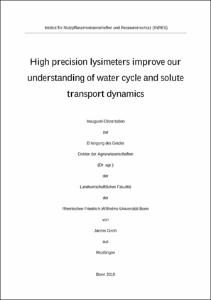High precision lysimeters improve our understanding of water cycle and solute transport dynamics

High precision lysimeters improve our understanding of water cycle and solute transport dynamics

| dc.contributor.advisor | Vereecken, Harry | |
| dc.contributor.author | Groh, Jannis | |
| dc.date.accessioned | 2020-04-24T15:45:13Z | |
| dc.date.available | 2020-04-24T15:45:13Z | |
| dc.date.issued | 28.11.2018 | |
| dc.identifier.uri | https://hdl.handle.net/20.500.11811/7379 | |
| dc.description.abstract | Water is the most precious natural resource on earth. Understanding the movement of water and dissolved substances between the different compartments soil, vegetation, and atmosphere is of crucial importance to resolve various environmental issues. The issue comprises the protection of groundwater quantity and quality, the optimization of crop production and the efficient use of fertilizer and crop protection products in agriculture. Predictive modeling of water and solute transport can help to provide information for decision makers to manage, protect and sustain these available natural resources. Models are a simplification of complex natural processes and connect known fluxes at the model boundaries with state variables from the unsaturated zone (vadose zone). The calibration of such models requires precise knowledge about the boundary conditions and state variables to identify the properties of the vadose zone that link fluxes with state variables, such as soil water retention characteristic, unsaturated hydraulic conductivity, and solute dispersion coefficient. The aim of this study was to investigate how beneficial are high precision lysimeter data to quantify water cycle components and how useful are such information's to calibrate a vadose zone model and obtain the parameters, to track the movement of water through the soil. We used synthetic and real lysimeter data to investigate the following objectives: (1) influence of changing surrounding subsurface conditions (soil texture and groundwater table) on the measured matric potentials that are used to control the water fluxes across the bottom boundary of transferred lysimeters in a climate change impact assessment, (2) do water from non-rainfall events (dew, hoar frost) contribute substantial to the water budgets of grasslands, (3) is nighttime evapotranspiration an relevant process that impacts the total evapotranspiration, and (4) are highly accurate water cycle terms, soil water content, matric potential, and water stables isotope data obtained from lysimeters simultaneously necessary to estimate water flow and solute transport parameters of a layered soil. Our investigation indicates that water cycle components are highly sensitive onto changes in subsurface conditions (soil texture and groundwater table) and thus climate change impact studies need to account for it. Lysimeter observations uncovered that non-rainfall water and nighttime water losses from evapotranspiration were until now unseen but relevant processes for the water budgets of grassland ecosystem. The simultaneous use of an accurate information on the complete water cycle, soil water content, matric potential, and stables isotope data obtained from lysimeter data were necessary during inverse model calibration to identify parameters of layered soils for the soil water retention characteristic, unsaturated hydraulic conductivity, and solute dispersion coefficient. In this work, we propose that high precision lysimeter combined with internal sensors devices provide the required observations to quantify complex key processes that control the energy and mass exchanges between atmosphere and subsurface and thus improve our understanding of the complete water cycle and solute transport dynamics in the vadose zone. | en |
| dc.language.iso | eng | |
| dc.rights | In Copyright | |
| dc.rights.uri | http://rightsstatements.org/vocab/InC/1.0/ | |
| dc.subject | Lysimeter | |
| dc.subject | Wasserhaushalt | |
| dc.subject | Tau | |
| dc.subject | Evapotranspiration | |
| dc.subject | Stofftransport | |
| dc.subject | water balance | |
| dc.subject | dew | |
| dc.subject | solute transport | |
| dc.subject.ddc | 630 Landwirtschaft, Veterinärmedizin | |
| dc.title | High precision lysimeters improve our understanding of water cycle and solute transport dynamics | |
| dc.type | Dissertation oder Habilitation | |
| dc.publisher.name | Universitäts- und Landesbibliothek Bonn | |
| dc.publisher.location | Bonn | |
| dc.rights.accessRights | openAccess | |
| dc.identifier.urn | https://nbn-resolving.org/urn:nbn:de:hbz:5n-52666 | |
| ulbbn.pubtype | Erstveröffentlichung | |
| ulbbnediss.affiliation.name | Rheinische Friedrich-Wilhelms-Universität Bonn | |
| ulbbnediss.affiliation.location | Bonn | |
| ulbbnediss.thesis.level | Dissertation | |
| ulbbnediss.dissID | 5266 | |
| ulbbnediss.date.accepted | 29.10.2018 | |
| ulbbnediss.fakultaet | Landwirtschaftliche Fakultät | |
| dc.contributor.coReferee | Diekkrüger, Bernd |
Files in this item
This item appears in the following Collection(s)
-
E-Dissertationen (1108)




